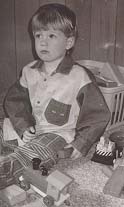During the years from birth to five years, the child is
checked regularly by the pediatrician concerning his ears,
throat, eyes, heart, lungs, digestive tract. In other words,
is this child's body functioning efficiently?
 Many
children get ear infections. The ears are examined and if
the infections have occurred a number of times there may be
a hearing test performed, and various tests that zero in on
the ears. But the ear isn't something sitting out there in
space. The ear is part of a total mechanism in this body.
For example, the ear itself is held in what we call the
temporal bone. (If you feel just behind your ear you will
feel a somewhat pointed bone, which is the mastoid
process.)
Many
children get ear infections. The ears are examined and if
the infections have occurred a number of times there may be
a hearing test performed, and various tests that zero in on
the ears. But the ear isn't something sitting out there in
space. The ear is part of a total mechanism in this body.
For example, the ear itself is held in what we call the
temporal bone. (If you feel just behind your ear you will
feel a somewhat pointed bone, which is the mastoid
process.)
From the inner part of the ear, that is known as the middle
ear, the Eustachian tube extends into the throat. Therefore,
what goes on in the throat has a bearing on what goes on in
the middle ear, and vice versa. Not infrequently the problem
may begin as a sore throat, a cold, and it progresses to an
ear infection. Therefore, the state of the throat and the
state of the ear are very intimately related.
Let's come back to the temporal bone for a moment. The
temporal bone articulates, or is connected to most of the
other bones of the head, directly or with one bone in
between. So, if this child has had a fall on the back of the
head in which the articulation between this bone and the
occipital bone at the back of the head has been jammed, the
bones cannot move freely, one in relationship to the
other.
Perhaps at the time of the injury the child cried for a
little while, had a bruise there or a swelling, and it
passed. A few weeks later an ear infection develops. If you
stop to think about it, you will find the ear infection has
developed on the same side on which the head injury
occurred.
The blood supply to the ear by way of the arteries, the
venous drainage from the ear by way of the veins, and the
lymphatic drainage is impaired if that normal, rhythmic
mobility of the temporal bone is interrupted. If there has
been an injury it has interfered to some degree with the
inherent mobility of that bone. Furthermore, if the child
fell on the back of the head, that fall may have disturbed
the alignment of the bones of the neck. The blood supply
passes through the neck up into the temporal bone.
So the ear problem is not confined to the ear. It may be
related to certain things that have happened in levels below
the ear. Now we begin to see that we cannot localize ear
infection in an ear because it is tied in to other parts of
the body. Of course, the circulation begins at the heart and
ends at the heart, so anything between the heart and the
temporal bone may be a factor in that circulation. The
lymphatic drainage is associated with certain structures in
the neck, going all the way down to below the collar bone.
Anything in this area may have a bearing upon that ear
infection.
It is not uncommon to get the story that this child has
had ear infections over and over again. Perhaps the first
ear infection occurred when he was six weeks of age. He was
treated with an antibiotic, he got over it; two months later
there was another ear infection. He was treated with
antibiotics, he got over it and six weeks later there was
another ear infection, and so it has gone on, perhaps for
several years, one after another.
At some point the parents decide there must be some other
way. Also, by this time the child may have reduced hearing
in one or both ears.
This is the time to go back structurally and inquire
whether there is any evidence of injury at birth which may
have started the process, and whether there had been any
injuries since then to which the child is now responding
with this susceptibility to infection.